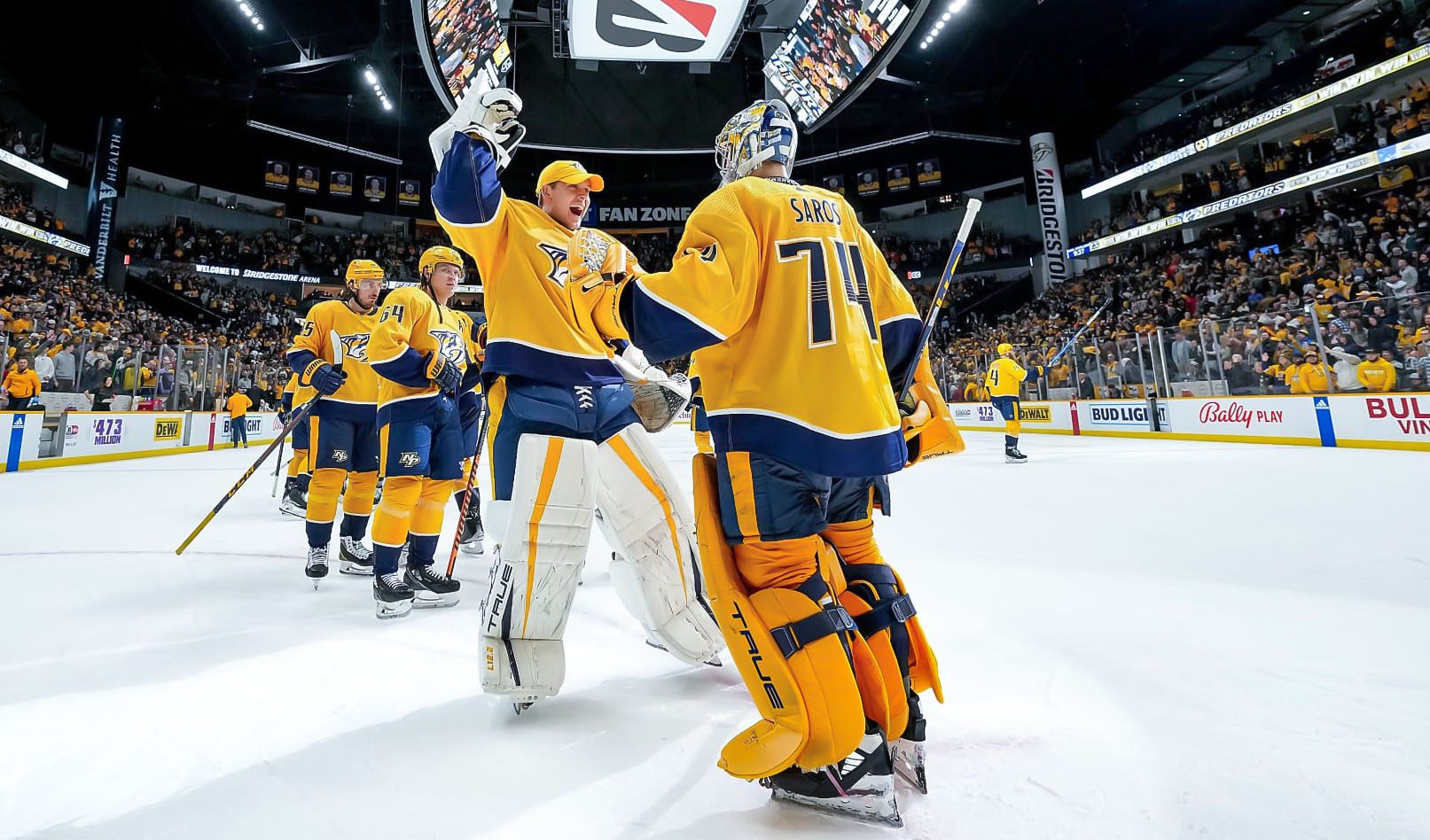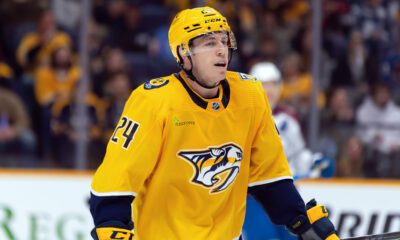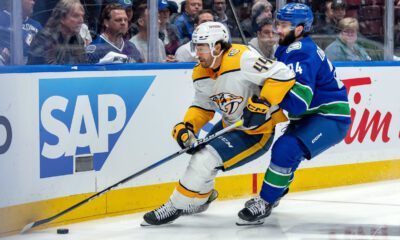Nashville Predators
What Should The Predators Do With Their Goalie Surplus?

With 31 games remaining in the season and just 13 games until the March 8 trade deadline, the Nashville Predators have plenty of questions left unanswered.
The most prevalent of these questions is what does general manager Barry Trotz do about his goaltending situation with an elite starter, a backup that could likely start for one-third of the league, and a red-hot prospect tearing up the AHL and champing at the bit to get to the NHL?
Contract breakdowns
The three goaltenders in question are Juuse Saros, Kevin Lankinen, and Yaroslav Askarov.
Saros currently has an annual cap hit of $5 million and he becomes an unrestricted free agent next summer. If he were traded today, the acquiring team (without salary retention) would absorb next season’s full $5M salary and a pro-rated $1.77M for the remainder of this season.
For context, there are 68 days remaining in the regular season as of Feb. 10, so any pro-rated value is based on that timeline. There are 192 days in the 2023-24 regular season.
The earliest the Predators are able to re-sign Saros to a contract extension, which Trotz has said several times is his intention, is July 1.
Conversely, Lankinen has an annual salary of $2M, but because he’s a free agent after the season, any team acquiring him would be adding minimal salary. If traded today (again, without retention) his cap hit would be $708,333. The Predators can re-sign Lankinen at any time, should they choose to do so.
Askarov is a specialized case. He will be a restricted free agent the same summer that Saros will be a UFA, Because Askarov is in the American Hockey League currently, the salary cap nuances that come with trading him are different because of the split-salary when playing in the AHL versus the NHL. For purposes of this exercise though, his cap hit would be nominal.
Because Askarov signed his three-year entry-level contract with the Predators at the age of 20 (based on age at Sept. 15, 2022, as opposed to signing date of May 17, 2022) he will have accumulated enough professional years to be eligible for arbitration or an offer sheet from another team by the summer of 2025-26. Askarov will have played three professional seasons (AHL and NHL seasons count as for RFA accumulation) if he plays in ten professional games during the 2024-25 season. Ten games are the requirement to accumulate a professional season. It’s very unlikely he does not reach this milestone next season.
In short, Nashville may offer him a qualifying offer for his negotiating rights and agree to any deal it so chooses in the summer of 2025.
Never change, Yaroslav Askarov.
Never ever change.#AHLAllStar pic.twitter.com/YvOKbjwYSM— The Calder Times (@TheCalderTimes) February 5, 2024
Trade market
For starters, the king’s ransom the Predators could potentially get from a team looking to acquire Saros is perhaps a little misguided.
The nature of how teams use goaltenders is changing, and the trade market for goaltenders has been declining for some time. Who was the last goaltender to receive a huge return via trade? Granted, an elite goalie is rarely, if ever, on the trade market, but the market is still depressed nonetheless. I’m personally not sending top assets for a goaltender.
If a massive offer comes — i.e. two top prospects or young NHLers plus two high-round draft picks — then a trade should be entertained. But it’s tough to see that offer actually coming.
As I have written previously, the Predators should be shopping Lankinen because he has a lower cap hit, is only 28, and he would fit in perfectly with a contender or a team that’s on the verge of contending (a team like the New Jersey Devils would be a perfect fit), and Nashville risks losing him for nothing once the season ends.
Lankinen’s performances this season have been respectable, and he deserves a break on the numbers side of things since he’s only been given 10 starts against the top-tier teams.
Filip Forsberg had high praise for #Preds goaltender Kevin Lankinen after beating the Dallas Stars last night pic.twitter.com/h0EXgGhvZR
— Nashville Hockey Now (@NSHhockeynow) January 8, 2024
The only salary cap caveat regarding a Lankinen trade, and for any trade for that matter, is that any teams using long-term injured reserve — like the Devils — would have to absorb the full salary cap hit of as opposed to the pro-rated share. For Lankinen’s case, that would be the full $2M.
The Edmonton Oilers could also be interested in adding a goalie and they could now make a potential deal work (I believe that Lankinen and defenseman Alex Carrier would be a nice tandem deal that teams would be interested in, including both the Devils and Oilers).
Lankinen won’t command the kind of return Saros would, but that doesn’t worry me. A high-end prospect or a young NHL player, like Alexander Holtz or Dawson Mercer from New Jersey, would be enough in exchange for Lankinen and Carrier. These trades won’t be won on the day they’re made.
The most important thing for Trotz is to free up roster space, acquire young talent that can fit into head coach Andrew Brunette’s system, and catalyze the rebuild/reset.
The future between the pipes
I’ll continue to be a strong advocate for platooning goaltenders in the NHL. The days of a single netminder like Martin Brodeur playing 70-plus games per season are a thing of the past.
Goaltenders that play around 60 games per season and consistently make the playoffs typically end up making around 80-plus starts every year. Teams should more equally split regular-season contests and have a healthy competition before riding the hot hand into the playoffs.
There’s a future in Nashville where both Saros and Askarov can coexist in this scenario. Of course, it all comes down to where both players are at salary-wise come the summer of 2025.
Saros will be 30 and Askarov will be 23, and I would allocate roughly $9.5M for both without going a penny over $7.25M for Saros’ extension.
Here’s my reasoning.
There are three important comparable contracts for a Saros extension, in my opinion — Calgary’s Jacob Markstrom, 30 ($6M AAV), Winnipeg’s Connor Hellebuyck, 30 ($8.5M AAV), and Igor Shesterkin, 28, of the New York Rangers ($5.667M AAV). Markstrom and Hellebuyck recently signed long-term deals whereas Shesterkin will be a UFA the same time as Saros. Hr and Saros will be looking for raises.
Both Shesterkin and Saros will want a deal similar to Hellebuyck’s, which will likely be the standard on the player side. Shesterkin will presumably want to be the highest-paid goaltender in New York; his intra-state rival Ilya Sorokin, who’s also 28, just signed an eight-year, $66M contract ($8.25M AAV) with the New York Islanders. Not to mention Shesterkin will want to be the highest paid Russian goaltender as well. Sorokin is Russian, too.
Saros, in my opinion, should come in above Markstrom but below Hellebuyck and Shesterkin. I do not factor in Sorokin for Saros because the extra two years between 28 and 30 is important for a goaltender’s value.
Splitting the difference between Hellebuyck, what Shesterkin is likely to command, and Markstrom’s deals results in approximately a $7.25M cap hit. If given a six-year deal, it would bring Saros’ total money to $43.5M. That deal can also be moved later on should the Predators decide to go all-in on Askarov as the No. 1 starter.
If I’m Trotz, I would be prepared to walk away from the negotiating table if that value and term can’t be reached. I’m not getting stuck into a bad contract out of fear. From Saros’ perspective, a modified no-trade clause could be acceptable in exchange for the possible lower cap hit, but Nashville’s priority should be to maintain flexibility to Saros’ deal down the line. A full no-trade should be off the table.
This leaves roughly $2.25M for Askarov on a bridge deal of approximately two to three years. I believe Askarov is the real deal, but he needs to prove himself consistently in the NHL before receiving anything close to the going rate for NHL starters.
Timing is everything here, and it’s important to note that the salary cap is likely to start increasing year-by-year now that the COVID revenue issue is in the rearview.
Additionally, the Predators will get back some more funds down the line when they shed Ryan Johansen’s $4M dead cap after the 2024-25 season and Mattias Ekholm’s $250k dead cap after the 2025-26 season, plus Matt Duchene’s buyout decreases from $6.5M to $1.5M after the 2025-26 season.
A hard salary cap is difficult to navigate, but creativity unlocks a variety of opportunities. Again, the most important commodities, in my opinion, for any general manager is roster flexibility and salary cap space. Nashville has the latter, it’s time to create the former.
Follow Clay Brewer on Twitter/X: @ClayBrewer10
Be sure to follow Nashville Hockey Now on X/Twitter, Facebook, YouTube and Instagram.

















